Numerical Analysis of Electric Field in Oil-Immersed Current Transformer with Metallic Particles Inside Main Insulation
Abstract
1. Introduction
2. Finite Element Electric Field Simulation
2.1. Comsol Finite Element Electric Field Simulation Logic
2.2. Simulation Parameter Setting
2.3. Typical Defect Design
3. Flawless Simulation
4. Elliptical Metallic Particle Defect Simulation
4.1. Electric Field Distribution Under Different Sizes of Elliptical Defects
4.2. Electric Field Distribution Under Different Positions of Elliptical Defects
5. Flake Metallic Particle Defect Simulation
5.1. Electric Field Distribution Under Different Sizes of Flaky Defects
5.2. Electric Field Distribution Under Different Positions of Flaky Defects
6. Conclusions
- (1)
- When compared to angular flaky metallic particles, smooth-surfaced elliptical metallic particles were observed to exert a more pronounced influence on the electric field distortion within the main insulation. Moreover, for particles of the same shape, the longer the metallic particles, the greater their influence on the electric field intensity distribution. Among these, the electric field distortion rate caused by elliptical metallic particles with a semi-axis of 9 mm is the highest, with a maximum electric field intensity of 45.1 × 106 V/m. The maximum electric field intensity resulting from flaky metallic particles with a length of 30 mm is 28.9 × 106 V/m. The longer the metallic particles, the stronger the electric field concentration effect becomes.
- (2)
- By analyzing the influence of the two shapes on the electric field distribution at different positions, it is found that the closer the particles are to the inner side, the greater their influence on the electric field intensity of the main insulation. Compared to the defect-free condition, the electric field enhancement coefficient is 4.15 for elliptical defects near the inner side and 0.78 for flaky defects near the inner side. As the position of metallic particles shifts from the inner to the outer side, the insulation performance of the main insulation gradually recovers, thereby reducing the risk of insulation breakdown.
Author Contributions
Funding
Data Availability Statement
Conflicts of Interest
References
- Mahajan, S.M.; Robalino, D.M.; Sivan, V. Thermal Modeling of an Inverted-Type Oil-Immersed Current Transformer. IEEE Trans. Power Deliv. 2010, 25, 2511–2518. [Google Scholar]
- Velásquez, A.M.R.; Lara, M.V.J. Current transformer failure caused by electric field associated to circuit breaker and pollution in 500 kV substations. Eng. Fail. Anal. 2018, 92, 163–181. [Google Scholar]
- Zhang, L.; Guo, M.; Chen, Z.; Du, L.; Zhang, R.; Yang, Y.; Ma, H. Diagnosis and Analysis of Current Transformer. Transformer 2011, 48, 57–59. (In Chinese) [Google Scholar]
- Wang, Q.; Yang, B.; Che, C.; Yang, W.; Zhang, J.; Dou, B. Diagnosis and Analysis of a 110kV Oil-immersed Current Transformer with Partial Discharge Defects. In Proceedings of the 2020 IEEE 1st China International Youth Conference on Electrical Engineering (CIYCEE), Wuhan, China, 1–4 November 2020; pp. 1–5. [Google Scholar]
- Pei, L.; Li, H.; Niu, L.; Gao, N.; Zhang, Y.; Zhang, Y.; Pei, Y.; Yin, Q. Case Analysis of 220 kV Oil-immersed Current Transformer Defect. In Proceedings of the 2020 5th Asia Conference on Power and Electrical Engineering (ACPEE), Chengdu, China, 4–7 June 2020; pp. 2178–2182. [Google Scholar]
- Wang, W.; Gao, Y.; Zhao, H. The Effect of a Metal Particle on Surface Charge Accumulation Behavior of Epoxy Insulator with Zoning Coating. Energies 2022, 15, 4730. [Google Scholar] [CrossRef]
- Li, S.; Li, J.; Tang, H.; Deng, J. Motion Characteristics Analysis of Free Metal Particles in DC Bushing. High Volt. Appar. 2021, 57, 162–170. (In Chinese) [Google Scholar]
- Wang, J.; Wen, G.; Jiang, D.; Huang, Z.; Zhang, Y.; Pan, C. Partial Discharge and Breakdown Characteristics of Flowing Transformer Oil Containing Metal Particles. Insul. Mater. 2023, 56, 66–70. (In Chinese) [Google Scholar]
- Tang, J.; Ma, S.; Li, X.; Zhang, Y.; Pan, C.; Su, J. Impact of Velocity on Partial Discharge Characteristics of Moving Metal Particles in Transformer Oil using UHF Technique. IEEE Trans. Dielectr. Electr. Insul. 2016, 23, 2207–2212. [Google Scholar]
- Wang, B.; Niu, B.; Li, J.; Liu, W.; Chen, L.; Bai, T. Motion Behavior and Partial Discharge Characteristics of Metal Particles in Tip Electrode Under Mechanical and Electrical Combined Action. High Volt. Appar. 2023, 59, 127–135. (In Chinese) [Google Scholar]
- Yao, Y.; Tao, X.; Yu, M.; Pan, C.; Tang, J. DC Breakdown Characteristics of Flowing Transformer Oil Contaminated by Metallic Particles. Trans. China Electrotech. Soc. 2023, 38, 157–167. (In Chinese) [Google Scholar]
- Zhao, J.; An, Z.; Lv, B.; Wu, Z.; Zhang, Q. Characteristics of the Partial Discharge in the Development of Conductive Particle-Initiated Flashover of a GIS Insulator. Energies 2020, 13, 2481. [Google Scholar] [CrossRef]
- Yao, R.; Hui, M.; Li, J.; Bai, L.; Wu, Q. A New Discharge Pattern for the Characterization and Identification of Insulation Defects in GIS. Energies 2018, 11, 971. [Google Scholar] [CrossRef]
- Luo, H.; Gong, D.; Li, S.; Zhan, Z.; Di, N.; Dolkun, D.; Fan, X.; Liu, X. Suppression of Metal Particles by Coating for a ±550 kV DC GIS. Energies 2024, 17, 5627. [Google Scholar] [CrossRef]
- Wu, Z.; Wu, M.; Zhang, R.; Liao, L.; Du, G.; Huang, X.; Jin, W.; Zhang, J.; Li, H.; Lu, B. Simulation of Electric Field Distribution in Cable Joint under the Influence of Metal Particle. IOP Conf. Ser. Mater. Sci. Eng. 2020, 790, 012133. [Google Scholar]
- Liu, Y.; Nie, K.; Li, C.; Li, Z.; Gao, W.; Meng, F.; Li, Q. Electric Field Simulation Analysis of Typical Defects of Metal Particles in Main Insulation of Converter Transformer Based on Multi-physics Coupling. In Proceedings of the 5th International Symposium on Plasma and Energy Conversion; Fang, Z., Zhang, C., Mei, D., Zhang, S., Eds.; Springer Nature Singapore Pte Ltd.: Singapore, 2024; Volume 398, pp. 449–459. [Google Scholar]
- Deng, J.; Gao, K.; Ren, M.; Huang, H.; Jin, L. Electric Field Analysis of Multi-shape Metal Particle Adhesion Defects in 110 kV GIS. J. Electr. Eng. 2024, 19, 316–324. (In Chinese) [Google Scholar]
- Liu, Y.; Xia, B.; Du, B.; Farzaneh, M. Influence of Fine Metal Particles on Surface Discharge Characteristics of Outdoor Insulators. Energies 2016, 9, 87. [Google Scholar] [CrossRef]
- Dong, M.; Zang, C.; Zhan, Z.; Xin, W. Research Progress on Metal Particle Issues Inside GIL. High Volt. Appar. 2024, 60, 1011–1025. (In Chinese) [Google Scholar]
- Ma, S.; Tang, J.; Zhang, M.; Liu, Z.; Li, X. Simulation Study on Distribution and Influence Factors of Metal Particles in Traction Transformer. High Volt. Eng. 2015, 41, 3628–3634. (In Chinese) [Google Scholar]
- Wei, B.; Wang, Z.; Qi, R.; Wang, X.; Zhao, T. A Study on the Motion Behavior of Metallic Contaminant Particles in Transformer Insulation Oil under Multiphysical Fields. Sensors 2024, 24, 5483. [Google Scholar] [CrossRef]
- Shen, F.; Gao, Y.; Chen, Y. Analysis on Influence of Metal Particles in Different Positions on Electric Field of GIS Disconnector. High Volt. Appar. 2024, 60, 113–119. (In Chinese) [Google Scholar]
- Sha, W.; Luo, Y.; Ma, P.; Qi, L. Study on surface discharge and electric field characteristics of GIS basin insulator with different metal particle defects. Insul. Mater. 2023, 56, 89–93. (In Chinese) [Google Scholar]
- Ilunga, K.G.; Swanson, A.G.; Ijumba, N.; Stephen, R. Influence of Conductor Temperature on the Voltage–Current Characteristic of Corona Discharge in a Coaxial Arrangement—Experiments and Simulation. Energies 2025, 18, 1303. [Google Scholar]
- Lee, C.-H.; Cheng, P.-H.; Leou, K.-C.; Hsieh, C.-M.; Su, Y.-C. Calculation of the Optimal Magnetic Duty Cycle for a Graded Coaxial Magnet of a Rotary Type Magnetic Refrigerator. Energies 2025, 18, 289. [Google Scholar] [CrossRef]
- Leu, J.-H.; Su, A.; Kuo, S.-C.; Chen, K.-C. The Observation of Performance Trends by Numerical Simulation with Different Parameters in a Nonlinear Reversible Solid Oxide Cell System. Energies 2024, 17, 6083. [Google Scholar] [CrossRef]
- Zogning, C.; Lobry, J.; Moiny, F. Numerical Simulation of Corona Discharge Plasma Affecting the Surface Behavior of Polymer Insulators. Energies 2024, 17, 4247. [Google Scholar] [CrossRef]
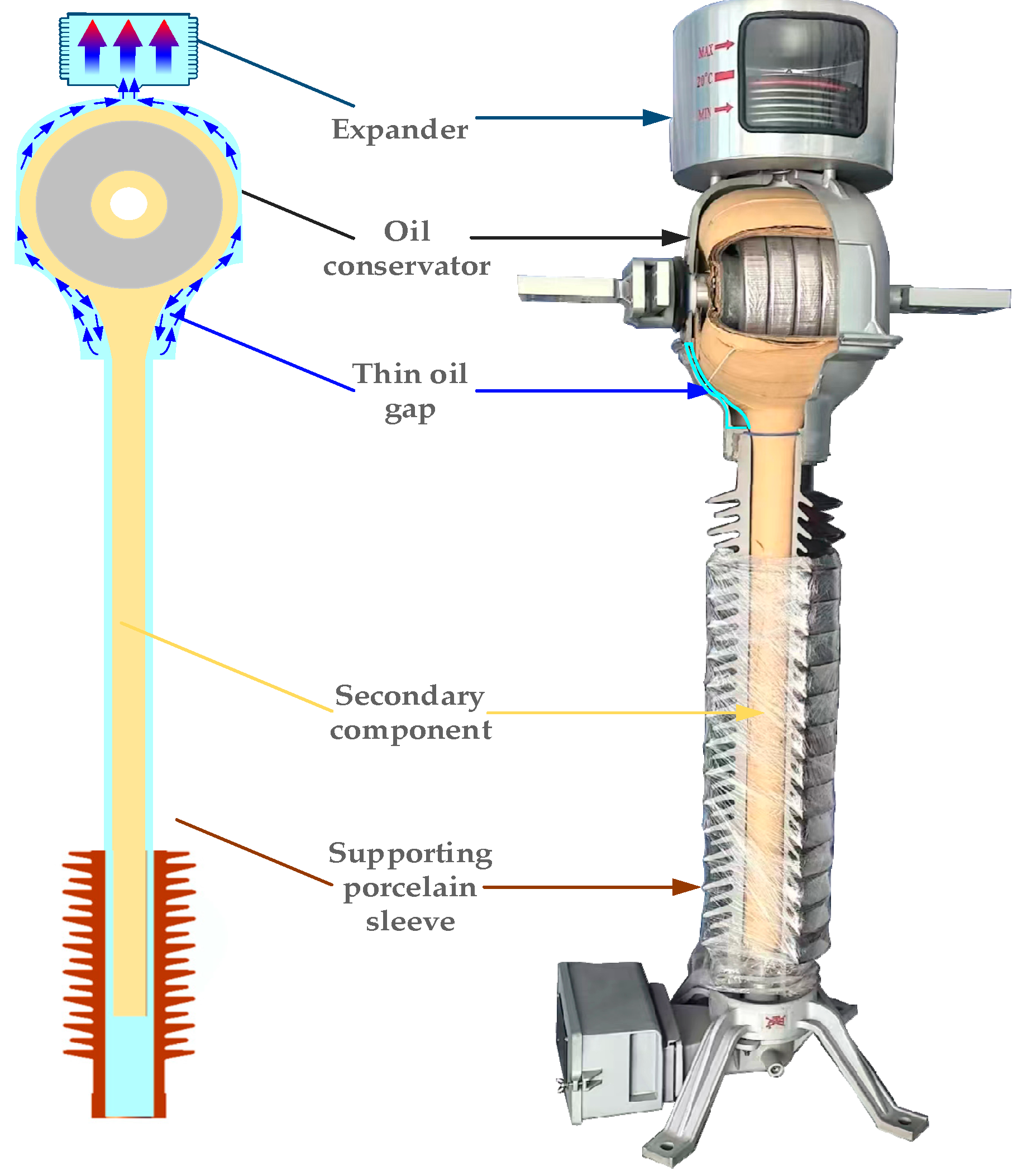
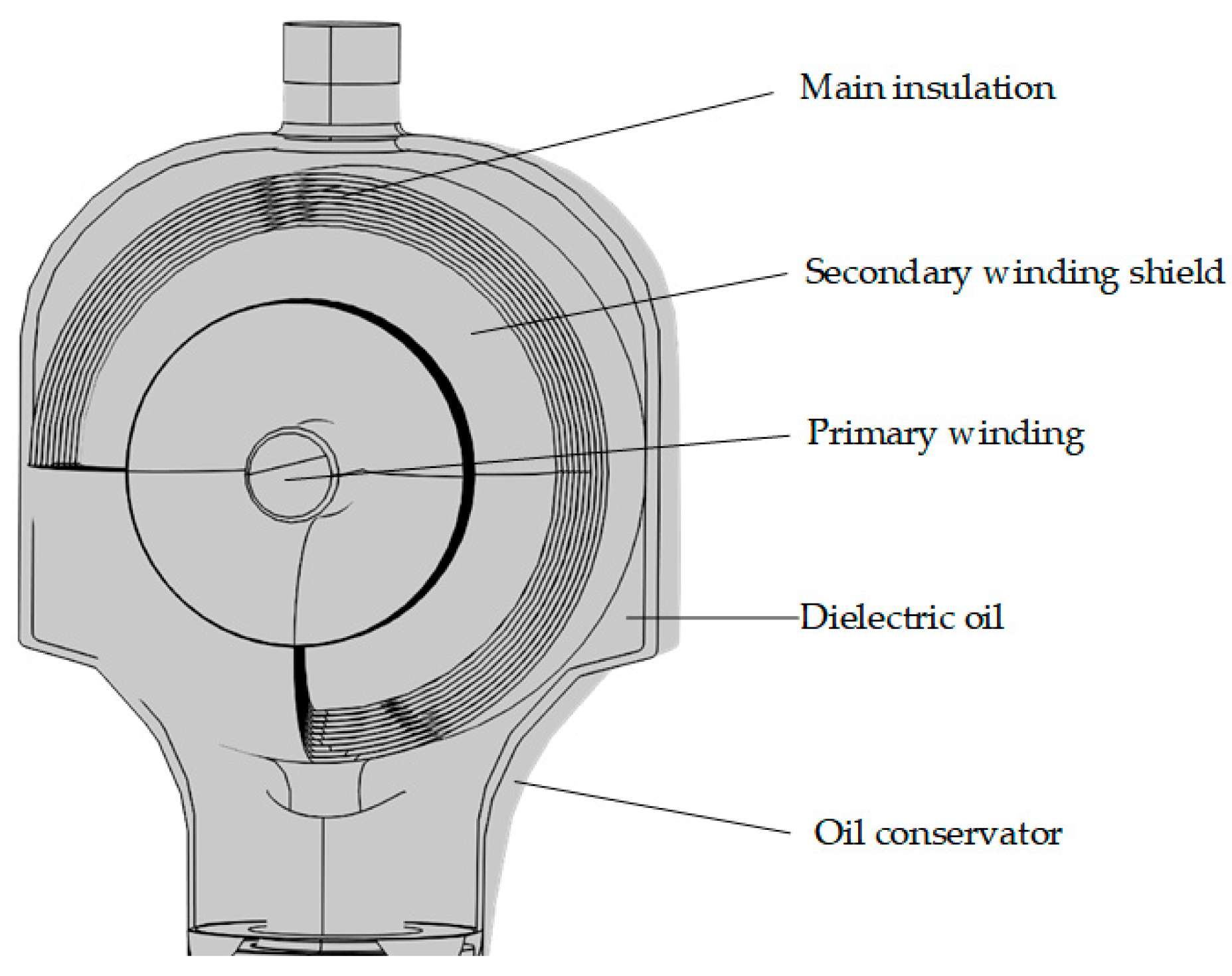
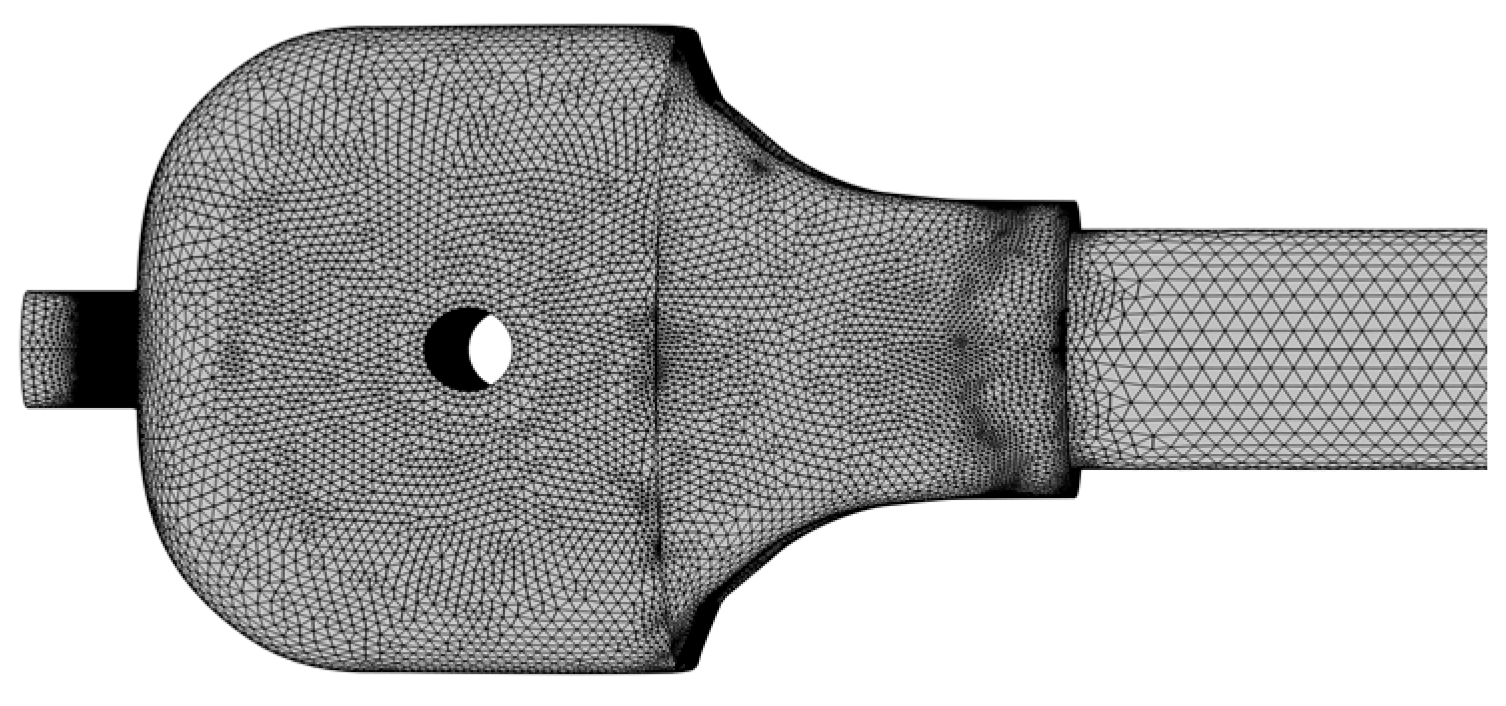

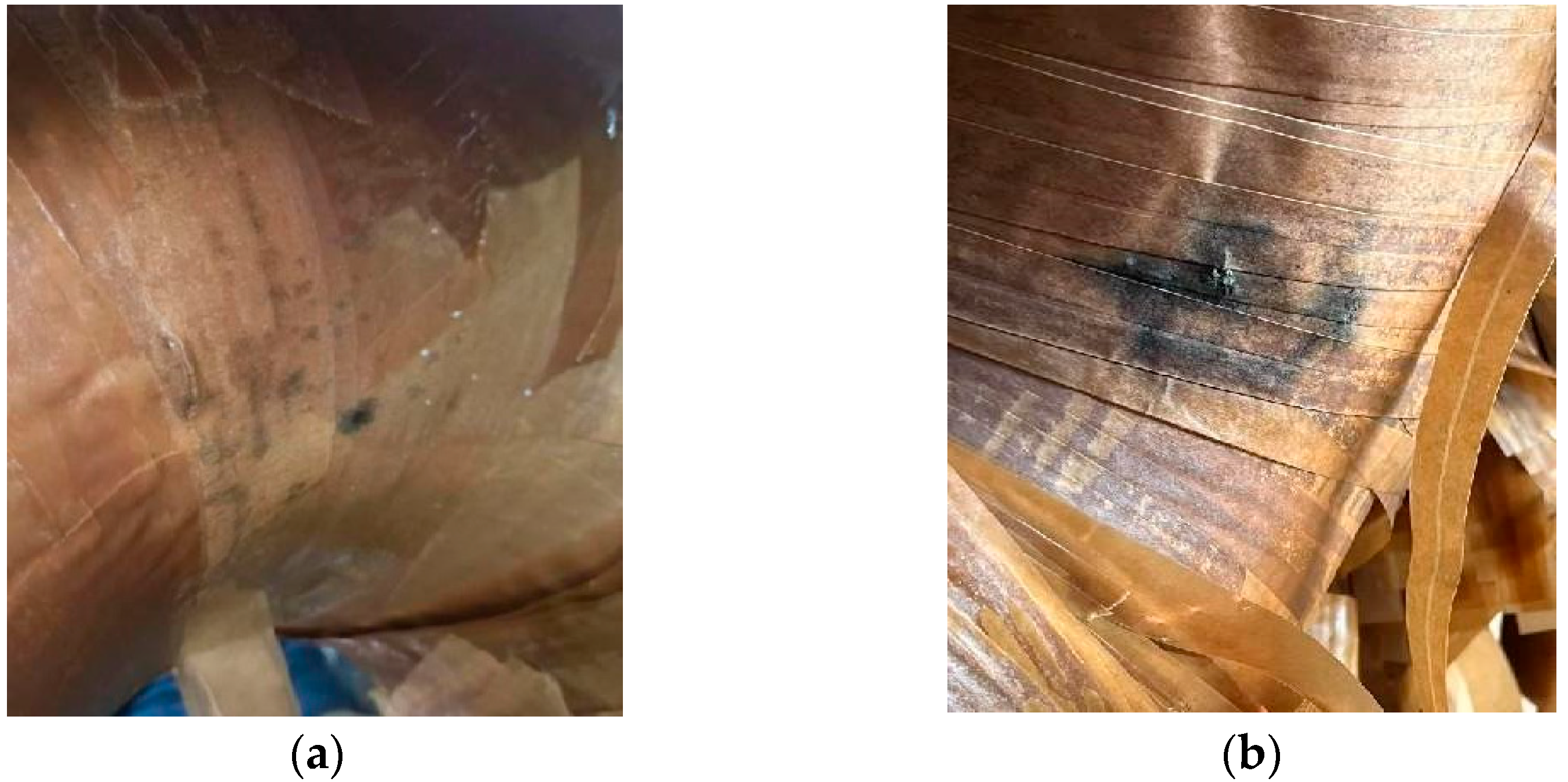




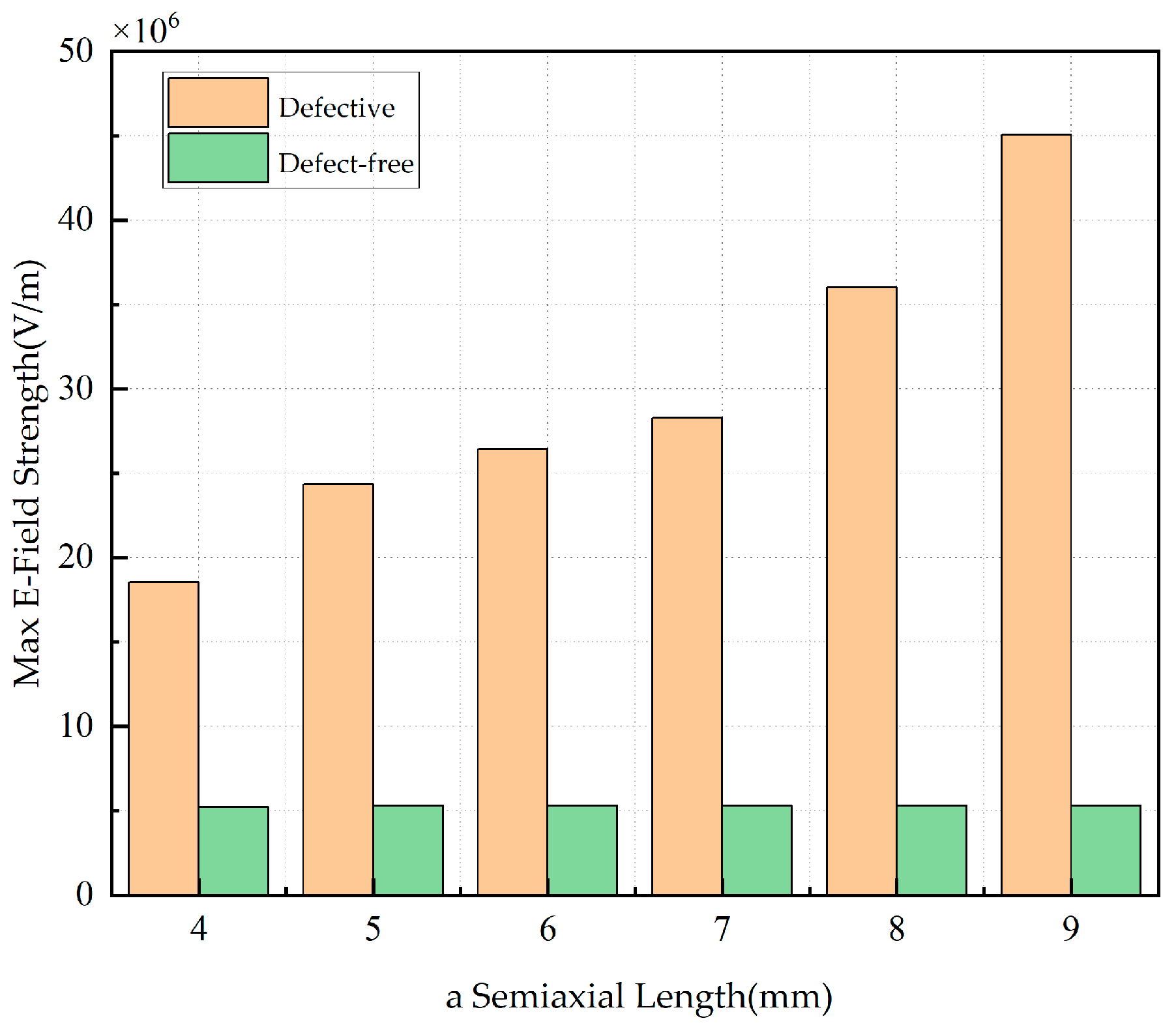

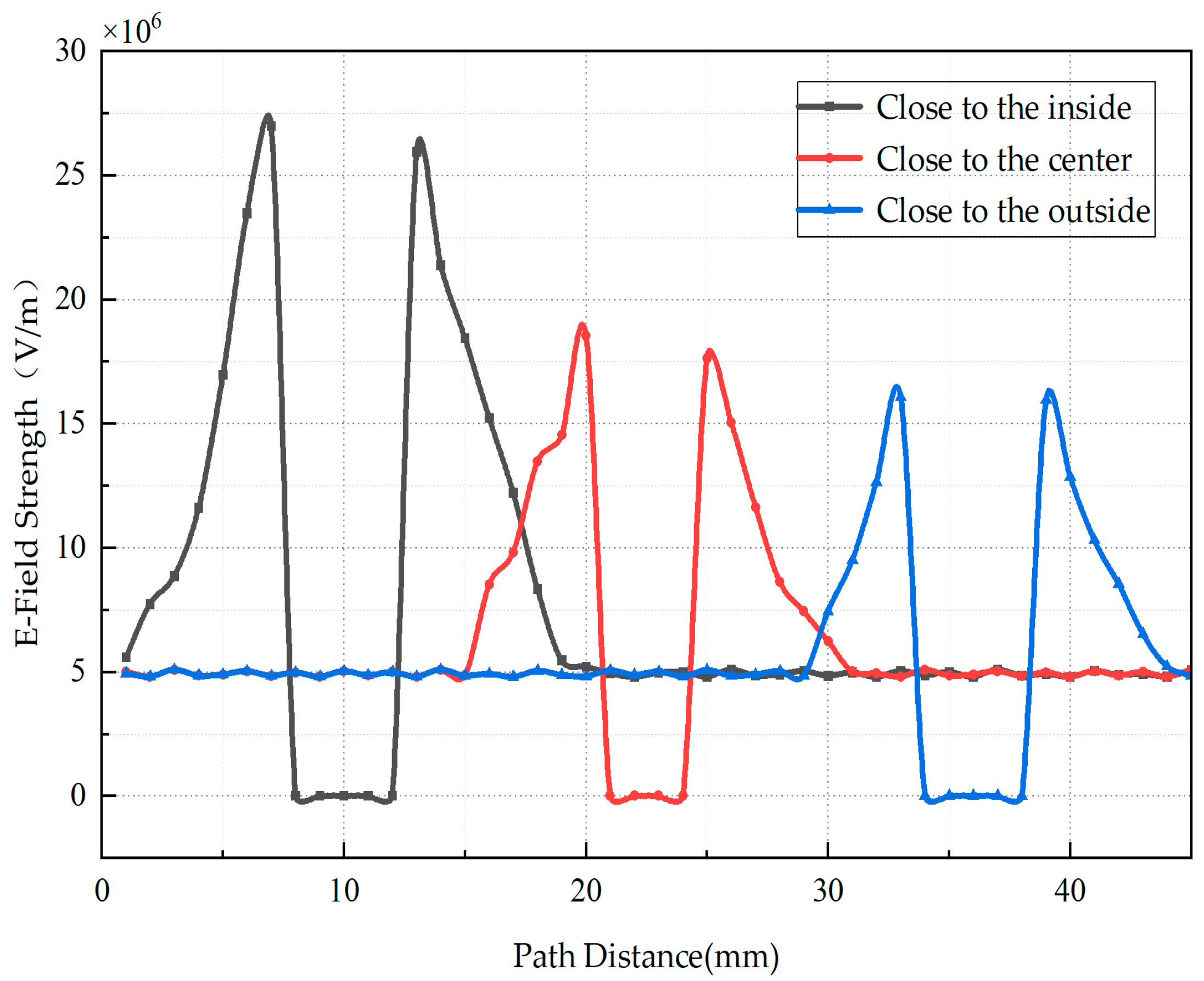
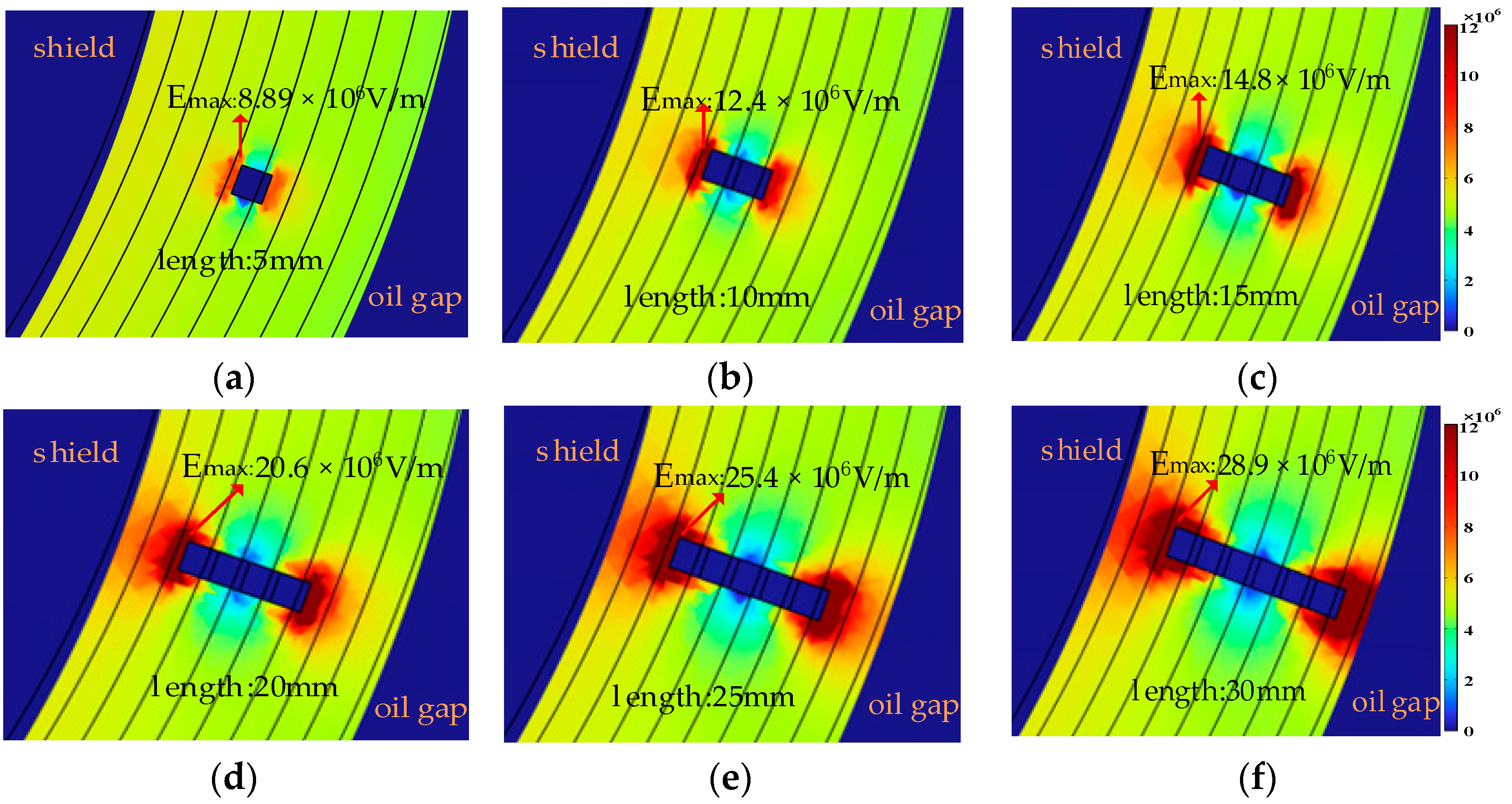
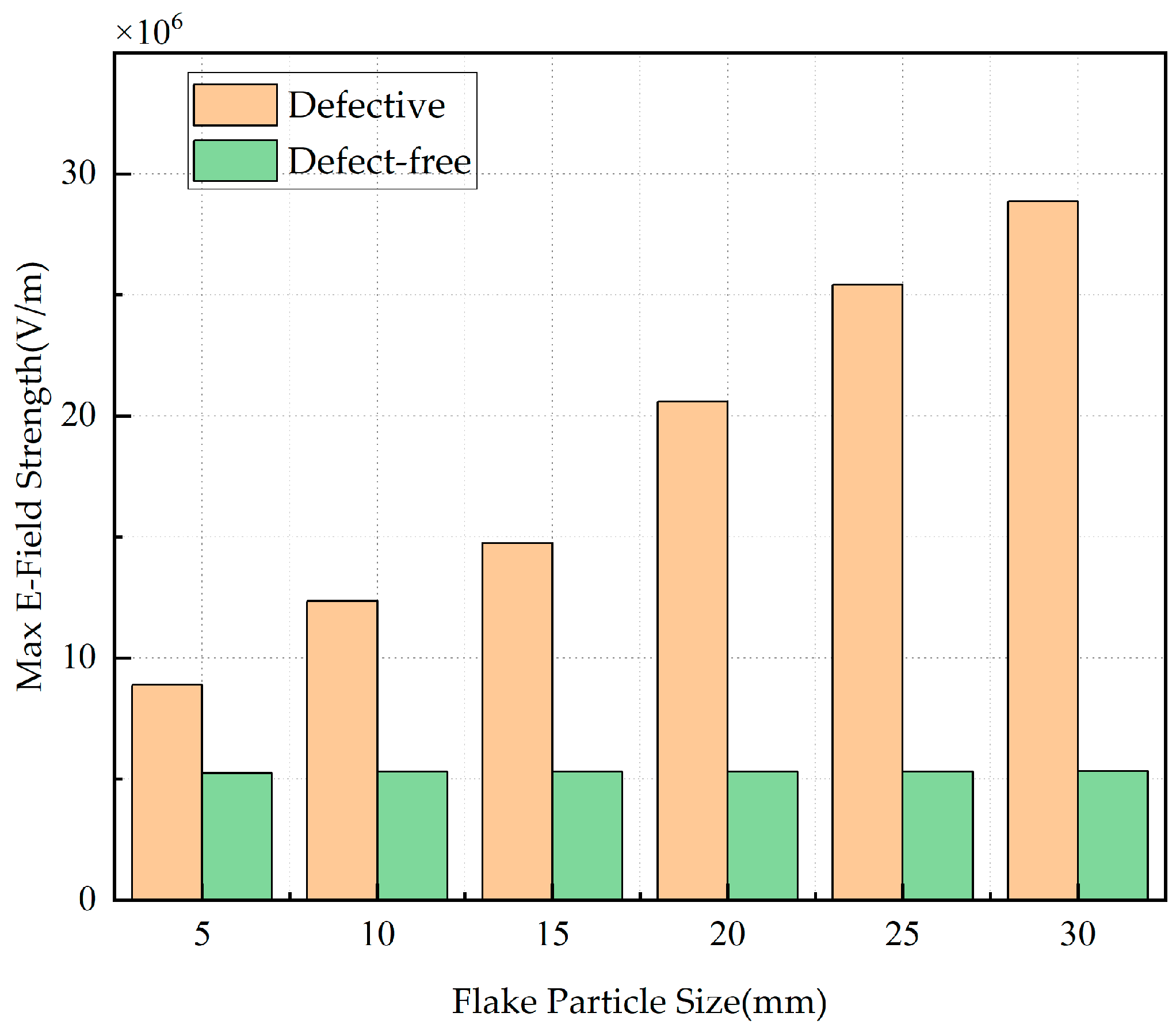


| Part Name | Material | Electrical Conductivity (S/m) | Relative Dielectric Constant |
|---|---|---|---|
| oil conservator | iron | 10.295 × 106 | 1 |
| secondary shield | aluminum | 3.774 × 107 | 1 |
| insulation paper | insulation paper | 9.9 × 10−4 | 3.5~4.4 |
| dielectric oil | transformer oil | 0.3 × 10−12 | 2.2 |
| Electric Field Intensity When There is Defect (V/m) | Electric Field Strength Without Defects (V/m) | |
|---|---|---|
| The metallic particles are close to the outside. | 16.9 × 106 | 5.12 × 106 |
| The metallic particles are located in the middle. | 18.5 × 106 | 5.26 × 106 |
| The metallic particles are close to the inside. | 27.8 × 106 | 5.41 × 106 |
| Electric Field Intensity When There is Defect (V/m) | Electric Field Strength Without Defects (V/m) | |
|---|---|---|
| The metallic particles are close to the outside. | 7.97 × 106 | 5.08 × 106 |
| The metallic particles are located in the middle. | 8.89 × 106 | 5.21 × 106 |
| The metallic particles are close to the inside. | 9.64 × 106 | 5.42 × 106 |
Disclaimer/Publisher’s Note: The statements, opinions and data contained in all publications are solely those of the individual author(s) and contributor(s) and not of MDPI and/or the editor(s). MDPI and/or the editor(s) disclaim responsibility for any injury to people or property resulting from any ideas, methods, instructions or products referred to in the content. |
© 2025 by the authors. Licensee MDPI, Basel, Switzerland. This article is an open access article distributed under the terms and conditions of the Creative Commons Attribution (CC BY) license (https://creativecommons.org/licenses/by/4.0/).
Share and Cite
Lou, W.; Lu, B.; Pan, Y.; Han, Z.; Wang, L. Numerical Analysis of Electric Field in Oil-Immersed Current Transformer with Metallic Particles Inside Main Insulation. Energies 2025, 18, 3628. https://doi.org/10.3390/en18143628
Lou W, Lu B, Pan Y, Han Z, Wang L. Numerical Analysis of Electric Field in Oil-Immersed Current Transformer with Metallic Particles Inside Main Insulation. Energies. 2025; 18(14):3628. https://doi.org/10.3390/en18143628
Chicago/Turabian StyleLou, Wei, Bo Lu, Youxiang Pan, Zhou Han, and Lujia Wang. 2025. "Numerical Analysis of Electric Field in Oil-Immersed Current Transformer with Metallic Particles Inside Main Insulation" Energies 18, no. 14: 3628. https://doi.org/10.3390/en18143628
APA StyleLou, W., Lu, B., Pan, Y., Han, Z., & Wang, L. (2025). Numerical Analysis of Electric Field in Oil-Immersed Current Transformer with Metallic Particles Inside Main Insulation. Energies, 18(14), 3628. https://doi.org/10.3390/en18143628






